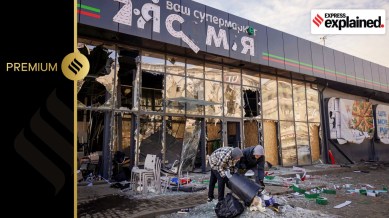Two years of Ukraine-Russian war: A timeline of Russian advance, Ukrainian counteroffensives, and stalemate
Russia launched the invasion with air strikes on major Ukrainian cities and a three-pronged ground invasion from the south, east, and north. In mid-March, Russian forces encountered stubborn resistance around Kyiv; March saw the highest civilian casualties of the war.

Prelude
(April 2021-Feb 2022)
From April 2021, Russia began to build up forces in Crimea and on the Ukraine border. The West was highly critical, but most experts did not believe that Russia would ultimately start a war. By February 2022, 190,000 Russian troops were massed at the Ukraine border.
🟥Russian military control; 🟨 Russian-backed separatist-held areas; 🟪 Area regained by Ukraine; 🚫Limited Russian military control
Initial months of the invasion
(Feb-July 2022)
Russia launched the invasion with air strikes on major Ukrainian cities and a three-pronged ground invasion from the south, east, and north. In mid-March, Russian forces encountered stubborn resistance around Kyiv; March saw the highest civilian casualties of the war. After Russia had pulled out from Kyiv by April 6, evidence of summary executions, torture, and rape emerged from the suburb of Bucha. On April 14, Ukraine struck a massive symbolic blow by sinking the Moskva, the flagship of Russia’s Black Sea fleet.
On April 18, Russia launched an offensive in the east. Mariupol fell on May 20. By month-end, Russia controlled all Ukrainian Black Sea ports except Odesa.
Through June, Russia gained ground in Luhansk province. Meanwhile, the Russian naval blockade of Ukraine had caused a global food crisis. On July 22, Moscow and Kyiv signed the Black Sea Grain Initiative to allow the free movement of grain ships from Russia-controlled Ukrainian ports. By the end of the month, all of the eastern province of Luhansk was in Russian hands.
Ukraine fights back
(Aug-Dec 2022)
During this phase, the heaviest fighting was in southern Ukraine. There were fears of a nuclear disaster after the Zaporizhzhia nuclear plant was caught in the crossfire. On August 29, Ukraine launched its first counter-offensive, in the Kharkiv region, and made some surprising gains. In September, Putin ordered partial mobilisation of hundreds of thousands of reservists. The Nord Stream pipeline was sabotaged on September 26.
On October 8, a large explosion badly damaged the Kerch Strait bridge on the major supply route for Russian forces in Ukraine. Russia responded with missile and drone strikes on Ukrainian cities and infrastructure.
Through the last three months of 2022, Ukraine retook significant territory in Kharkiv and cut off important Russian supply lines. Russia withdrew across the Dnipro river, as Ukraine took back Kherson. By the end of the year, only 14 per cent of Ukraine still remained under Russian control.
A bloody stalemate
(Jan-May 2023)
In January, several NATO countries promised tanks to Ukraine, which asked for fighter jets as well — a request that is yet to be granted. The war entered a stalemate, with both sides incurring massive costs for small gains.
The Battle of Bakhmut was symbolic of the high-cost, low-gain situation. After the Wagner private militia suffered heavy losses, tensions mounted between Wagner and Russian regulars. Meanwhile, Putin announced plans to “take all of Donbas” by March.
Bakhmut fell on May 20. The Russians suffered close to 100,000 casualties, including 20,000 deaths, according to US estimates.
summer counteroffensive
(June-Nov 2023)
An uptick in military activity around June 8, signalled the start of Ukraine’s counteroffensive. On June 24, the Wagner Group mutinied, captured Russian cities, and started to march towards Moscow. However, it was put down in 36 hours, with Belarus’s President Aleksander Lukashenko brokering a deal.
By November, it was clear that the stated objective of the counteroffensive (to liberate all of Ukraine) would not be achieved. Ukrainians faced heavy casualties, and suffered heavy material losses. At the same time, support for Ukraine seemed to be dwindling in the West.
Latest developments
(Dec 2023-present)
With Kyiv under pressure, Russia launched a spate of missile and drone attacks. Ground operations continued as well. On February 16, Russia captured the town of Avdiivka, its most significant territorial gain in more than nine months.